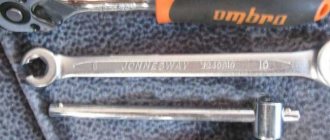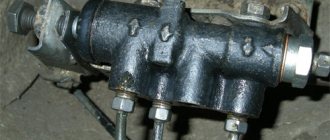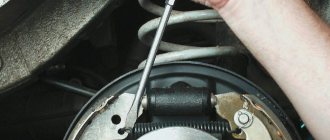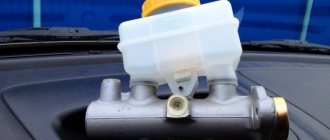Braking distance is the distance it takes for a vehicle to come to a complete stop from the moment the braking system begins to operate.
In everyday life, this term is often confused with stopping distance, but braking distance and stopping distance are different concepts. In the latter case, the distance elapsed from the moment the driver realized the need to brake to a speed of 0 km/h is taken into account. The braking distance is part of the stopping distance.
What does braking distance depend on?
The indicator under consideration is not a constant value and can vary for a number of reasons. All factors influencing the braking distance can be divided into two large groups: driver-dependent and driver-independent. Reasons beyond the control of the person driving include:
It is easy to guess that in rain, snow or ice, the distance required to stop a car will be greater than on dry asphalt. Braking will also take a long time when driving on smooth asphalt, to which stone chips have not been added. Here the wheels have nothing to catch on, unlike rough surfaces.
Note: it is worth noting that poor quality of the road (potholes, potholes) does not lead to an increase in the distance required to stop. The human factor plays a role here. Trying to save the suspension, drivers rarely reach high speeds on such roads. Accordingly, the braking distance here is minimal.
Factors depending on the driver or owner of the car:
- brake condition;
- system design;
- presence of ABS;
- type of tires;
- vehicle load;
- movement speed.
The fact that the length of a car’s braking distance directly depends on the serviceability of the braking system does not require proof. A car with a malfunctioning brake circuit or worn out pads will never be able to stop as quickly as a working vehicle.
A lot depends on the design of the brake units. Modern cars equipped with rear disc brakes and brake assist systems have much better traction and shorter braking times.
In turn, the presence of EBD with ABS does not always help reduce the distance required to stop. On dry hard surfaces, where wheel locking occurs only with very intense braking, the system actually shortens the braking distance. However, on bare ice, the “smart” electronic assistant begins to reduce braking force even when you lightly press the brake pedal. At the same time, the car retains controllability, but its braking distance increases significantly.
What determines the rate of deceleration? Of course, it depends on the type of tires. So, on bare, albeit frozen, asphalt, as well as in slushy snow, the so-called brakes are best. “Velcro” are winter tires that are not equipped with studs. In turn, in icy conditions and on snowy roads, studded tires are the most effective. » alt=»»> An important factor influencing the size of the stopping distance is the speed and load of the machine.
It is clear that a lightweight car at a speed of 60 km/h will stop faster than a truck loaded to capacity and moving at a speed of 80-100 km/h. The latter will not be allowed to stop quickly by speed and inertia that is too high for him.
The main factor influencing the accuracy of the calculation
The only variable in the speed formula is the braking distance. Manual calculation of this value under ideal conditions (driving at a speed of 60 km/h on a dry asphalt road, braking without skidding) can be done using the formula
v – vehicle speed at the beginning of braking, m/s;
μ – friction coefficient;
g – free fall acceleration, m/s2.
Another formula to check the correctness of the initial calculation
Ke – the value of the braking coefficient;
V – speed at the moment of braking;
Фс – the value of the coefficient of adhesion of tires to the road surface (in dry weather - 0.7, in rainy weather - 0.4; in snow - 0.2; in ice - 0.1).
So, when driving on a dry asphalt road at a speed of 60 km/h, the braking distance will be S = 1*60*60/(254*0.7) = 20.25 m. When driving on an icy road, on which Fs drops from 0.7 to 0.1, the value of S will increase 7 times (141.7 m).
When and how measurements are taken
Braking distance calculations may be required in the following cases:
- technical testing of the vehicle;
- checking the capabilities of the car after modifying the brakes;
- forensic examination.
As a rule, the formula S=Ke*V*V/(254*Fs) is used in the calculation. Here S is the braking distance; Ke – braking coefficient; V₀ — speed at the start of braking; Фс – coefficient of adhesion to the coating.
The coefficient of road adhesion varies depending on the condition of the surface and is determined according to the following table:
| Road condition | Fs |
| Dry | 0.7 |
| Wet | 0.4 |
| Snow | 0.2 |
| Ice | 0.1 |
The Ke coefficient is a static value and is unity for all the most common passenger vehicles.
Example: how to calculate the braking distance of a car when the speedometer shows 60 km/h in the rain? Given: speed 60 km/h, braking coefficient – 1, adhesion coefficient – 0.4. We count: 1*60*60/(254*0.4). As a result, we get the figure 35.4, which is the braking distance in meters.
The table shows how many meters the car will continue to move until it comes to a complete stop. It should be taken into account that no other indicators are taken into account (turns, potholes on the road, oncoming traffic, etc.). It is doubtful that in real conditions on an icy road, a car will be able to slide for a kilometer without encountering a pole or bump stop.
What is needed to calculate braking distance
To calculate the braking distance, the formula of which is indicated in the figure with explanations, it is not enough to know instantaneous dry data.
Theoretically, to evaluate the braking performance of a car, it is necessary to use a lot of data:
- braking distance length;
- the minimum time for which the brake system will operate;
- range of changes in braking forces;
- algorithm for changing braking forces;
- brake performance depending on heating;
- quality of road surface;
- car suspension efficiency;
- degree of wear and type of tires.
More on InDrive.Net:
Calculation of the braking distance of a car
There are a number of points to consider here. For example, the effectiveness of the braking system in each car can be different and this goes without saying. The hydraulic brake system gives a delay of at least 0.2-03 s, and the pneumatic brakes installed on most trucks and buses are even longer, up to 0.6 s. In addition, there is such a thing as an increase in braking force from zero to a maximum value, and this also takes from 0.4 to 0.6 s, while the influence of speed on the braking distance in this case increases squared, that is, with increasing speed is doubled, the braking distance will be four times longer.
How to increase the intensity of deceleration
From the above, it became clear what is called the braking distance and what this indicator depends on. However, is it possible to reduce the distance required to stop a car? Maybe! There are two ways to do this - behavioral and technical. Ideally, the driver combines both methods.
- Behavioral method - you can reduce the braking distance if you choose a low speed on slippery and wet roads, take into account the degree of load of the car, and correctly calculate the braking capabilities of the car depending on its condition and model year. Thus, a Moskvich developed in 1985 will not be able to brake as effectively as a modern Hyundai Solaris, not to mention more respectable and technologically advanced models.
- Technical method - a method of enhancing braking capabilities, based on increasing the power of the braking system and the use of auxiliary mechanisms. Manufacturers of modern vehicles actively use such methods of improving brakes, equipping their products with anti-lock braking systems, braking assistance systems, using more efficient brake discs and pads.
It should be remembered that reducing the time required to stop is one of the ways to ensure a safe trip. Therefore, every driver must constantly monitor the technical condition of his “iron horse”, promptly maintain and repair the braking system. In addition, it is important to choose the driving speed taking into account the surrounding situation: time of day, road condition, car model, etc.
After each traffic accident, the speed of the vehicle before and at the moment of impact or collision must be determined. This value is so important for several reasons:
- The most frequently violated point of traffic rules is precisely exceeding the maximum permissible speed, and thus it becomes possible to determine the likely culprit of the accident.
- Speed also affects the braking distance, and therefore the ability to avoid a collision or collision.
Dear reader! Our articles talk about typical ways to resolve legal issues, but each case is unique.
If you want to find out how to solve your particular problem, please use the online consultant form on the right or call.
It's fast and free!
How to determine car speed and braking distance? | Master Vintik. Everything with your own hands!
Below we consider a small free program for calculating the braking distance of a car at a known speed and vice versa (you can calculate the speed at a known braking distance).
Braking distance is the distance covered by a vehicle from the moment the braking device is activated until it comes to a complete stop.
The complete braking distance also includes the distance covered during the time from the moment the driver (driver) perceives the need to brake until the brake controls are activated.
The braking distance is proportional to the square of the driving speed, the speed at which the brakes are applied, the load on the braked wheels, the coefficient of adhesion between the wheels and the road, and also depends on the driver’s reaction.
The length of the braking distance depends on the condition of the braking system, the speed of the vehicle, the condition of the road, as well as the condition and quality of the tires. When the vehicle speed increases, for example by 2 times, the braking distance increases approximately 4 times.
On a wet road, the braking distance of a passenger car increases by 2 times compared to a dry road, and on a snowy and icy road surface - by approximately 4 times.
The stopping distance includes the braking distance, as well as the distance that the car travels during the driver’s reaction (from awareness of the danger to the start of pressing the brake pedal). The distance covered by the car during the driver's reaction time, the car moves at a constant speed.
How to determine the speed of a car based on the braking distance?
Equally slow motion: v x v/2=Sa,
where v is the speed before braking begins,
S - distance traveled (the length of the black trace of rubber smeared on the asphalt),
a - acceleration (deceleration) during braking.
This is taken from the transition of ALL kinetic energy into the work of friction (rubber destruction, i.e. black mark). The adhesion coefficient value can be from 0.7-0.9 for dry asphalt and good tires to 0.03-0.01 on ice.
Skillful braking on the verge of wheel blocking (good ABS operation) can increase the friction coefficient by 10-20 percent, but this is not our case: since there is a black mark on the asphalt, the wheels were blocked. The minimum permissible brake efficiency for a passenger car is 0.
64 (for every ton of weight the braking force is 640 kg) is regulated in GOST 25478-91 for brakes in general. It is assumed that on dry asphalt (or on the rubber of the drum on the PIK) the grip of the rubber is much better, so this is the quality of the brakes themselves.
The stopping distance also includes the distance covered at the initial speed during the driver’s reaction time (0.2 sec) and the braking system response time (according to GOST 25478-91, no worse than 0.5 sec for passenger cars). There is no black mark left on the asphalt at this time, and in speed calculations, only the braking distance is used from the length of the braking mark.
The speed along the braking distance recorded in the protocol will be determined by the traffic police : they have a handwritten diagram, where the corresponding speed is set opposite a certain length of the braking distance; Plus or minus is not a big deal for them.
Calculation of braking distance and speed
The examination of the State Traffic Safety Inspectorate and the Ministry of Internal Affairs uses the following formulas and methods. You can find and do the calculations yourself.
Va =0.5 x t3 x j + v2Syu x j = 0.5 0.3 5 + v2 x 21 x 5 = 0.75 +14.49 = 15.24 m/s = 54.9 km/h
where: in the expression v2Syu x j, v is the square root of the entire expression, it just didn’t work out when writing.
Va is the initial speed of the car, m/s; t3 — vehicle deceleration rise time, s; j is the steady deceleration of the vehicle during braking, m/s2; (for wet pavement - 5 m/s2 according to GOST 25478-91 or the appendix below) for dry pavement j = 6.8 m/s2, hence the initial speed of the car at a skid of 21 m is 17.92 m/s, or 64.5 km /h; Syu - length of the brake track (skid), m.
S0 = S1 + S2 +S 3+ S4 = (t1 + t2 + 0.5 t3 ) Va + Va/2j , where: S0 is the vehicle’s path from the moment the driver begins to respond to danger to stopping (stopping distance); S1 + S2 +S3+ S4 - car paths for time intervals t1, t2, t3, t4; t1 — driver reaction time, -0.8 s; t2 - delay time of the hydraulic brake drive, selected 0.2 s.; t3 — deceleration rise time, 0.3 s; t4 = Vу/j = Va/j — 0.5t3 — time of complete braking, s.
T0 = t1 + t2 + t3 + t4 = T + Va / j; By taking T = t1 + t2 + 0.5 t3, you can easily calculate the stopping distance and stopping time of the car. This can be calculated to compare the driving conditions of two participants in an accident.
Braking distance S=Kе*V*V/(254*Фс) , where Ke is the braking coefficient (for a passenger car = 1); V — speed in km/h at the beginning of braking; Fc - road adhesion coefficient (=0.7 dry asphalt, 0.4 wet road, 0.2 compacted snow, 0.1 icy road).
Skid trail
In expert practice, it is generally accepted that skid marks caused by wheel locking remain only during the period of full braking (i.e.
braking to the floor), and the moment of the beginning of the trace formation coincides with the moment of the onset of steady-state deceleration, hence: Syu=Vyu*Vyu/2j, where Syu is the length of the braking trace (m); Vу - vehicle speed at the beginning of full braking (m/s) j - steady deceleration of the vehicle with full use of traction by all vehicle tires (m/(s*s))
This value is experimental and calculated; it may be different for a particular car.
It can be calculated using the following formula: j=f*g, where f is the coefficient of longitudinal adhesion of tires to the road - measured at the scene of an accident using a “fifth wheel” or portable devices, and g - 9.
8 m/(s*s) However, do not forget that before full braking begins, the car travels a certain distance with increasing deceleration, therefore Vу=Vа-0.
5*t(3)*j, where Va is the initial speed of the car, and t(3) is the deceleration rise time, which depends on the type of brake drive, the condition of the road surface and the weight of the car. With a pneumatic drive, it is greater than with a hydraulic drive, and increases with increasing coefficient of adhesion and vehicle weight.
Stopping distance S = (T1+T2+0.5*T3)*V/3.6 + V*V/(26*J), where: T1 = 0.8s - driver reaction time; T2 = 0.1s — delay time of the brake actuator; T3 = 0.35 — deceleration rise time; V = 70 km/h - speed; J = 6.8 - steady deceleration.
There is a table indicating in which situations what the driver's reaction should be. There T1 is in the range of 0.6 - 1.4 s (in increments of 0.2).
Why experts use 0.8 is not clear (each person has a different reaction - that’s why limits are applied), since already at T1 = 1s the result already changes (after this, the result of the examination can be completely opposite).
Let's compare the length of the braking trail and the speed of the car. The formula looks like this: Sу= 0.5xTзxVo + Vo2/(2xj), where: - initial speed of the car, m/s; Tz — vehicle deceleration rise time, s; j is the steady deceleration of the vehicle during braking, m/s2; (for wet coating - 5 m/s2, for dry coating j=6.8 m/s2 according to GOST 25478-91); Syu — length of the brake track (skid), m; Tz - according to traffic police methods = 0.3 s.
Category correspondence table
To make it easier for you to navigate the variety of categories of technical regulations, I have compiled a special table containing the corresponding categories of traffic rules and technical regulations. By looking at this table, you can immediately determine which category your vehicle belongs to.
| Category VU | Category of technical regulations |
| A | L3-L5 |
| B (passenger cars) | M1 |
| B (freight) | N1 |
| C | N2-N3 |
| D | M2-M3 |
| E | O2-O4 |
Using this table, you can easily determine the category of your vehicle according to technical regulations.
Program features:
The program allows you to calculate:
- car braking distance;
- braking distance speed;
- If you have a video recorder, the program will help you calculate the speed and time traveled.
Calculation of speed based on a known braking distance
At the top right, check the box “Length of brake track, skid is known”
On the left in the “Brake trail length” box, set the value in meters.
The calculated values are shown in the green boxes below in the red rectangle.
Calculation of braking distance by speed
At the top right, uncheck (if checked) “The length of the brake track, skid is known”
On the left in the “Speed” box, set the value in km/h.
The calculated values are shown in the green boxes below in the red rectangle.
The program has the ability to determine the speed using the recorder's time readings, driving along the road, noting the time from one support to another (blue text in the window on the left).
Installation: Download archive (link below). Unzip to any folder on your computer. Run the file: brakez.exe
Uninstallation: delete the folder with all program files.
Author's website : rzd2001.narod.ru
Size : 3MB
DOWNLOAD THE PROGRAM FOR FREE
Reference literature: 1. Ilarionov V.A. "Examination of road accidents." M., Transport, 1989. 2. Ilarionov V.A. “Tasks and examples for the examination of road accidents.” Tutorial. MADI. M., 1990 3. Korshakov I.K.
, Sytnik V.N. “Comprehensive analysis of road accidents.” Tutorial. MADI. M.1991 4. Ermakov F.
“Assessment of the reliability and objectivity of the conclusion of a judicial automotive technical examination” Russian Justice, No. 5, 1997.
P O P U L A R N O E:
- Program for working with analog signals - PowerGraph
- Free organizer for wide use.
The PowerGraph program is designed for recording, processing and storing analog signals recorded using analog-to-digital converters (ADCs), and allows you to use a personal computer as a regular tape recorder. Read more…
Determining vehicle speed by braking distance
The stopping distance is usually understood as the distance covered by a vehicle from the start of braking (or, to be more precise, from the moment the braking system is activated) to a complete stop. The general, non-detailed formula from which it is possible to derive a formula for calculating speed looks like this:
Va = 0.5 x t3 x j + √2Syu x j = 0.5 0.3 5 + √2 x 21 x 5 = 0.75 +14.49 = 15.24 m/s = 54.9 km/h where: in the expression √2Sу x j, where:
- Va is the initial speed of the car, measured in meters per second;
- t3 – vehicle deceleration rise time in seconds;
- j – steady deceleration of the vehicle during braking, m/s2; Please note that for a wet coating - 5 m/s2 according to GOST 25478-91, and for a dry coating j = 6.8 m/s2, hence the initial speed of the car at a “skid” of 21 meters is 17.92 m/s, or 64 .5km/h.
- Syu is the length of the brake track (skid), also measured in meters.
Based on the above equation, we can conclude that the braking distance is affected primarily by the speed of the car, which, if the other values are known, is not difficult to calculate. The most difficult part of the calculations using this formula is the exact determination of the friction coefficient, since its value is influenced by a number of factors:
- type of road surface;
- weather conditions (when the surface is wetted with water, the friction coefficient decreases);
- tire type;
- tire condition.
How to calculate the total stopping time and the final braking distance?
As we have already said, in order to calculate the entire braking distance, it is necessary to take into account the loss of time when the driver makes the decision to brake (that is, the driver’s reaction time). To do this, you need to use a different formula, which provides a more accurate approximate calculation of the braking distance that the car will travel at the moment the decision is made to stop. Here is the formula:
(Speed in km/h: 10) x 3 = reaction distance in meters
As a result, by making calculations using the above formulas, you can calculate the approximate final braking distance of your car at any speed. Here's an example. If you drive your car at a speed of 50 km/h, then using the given formulas calculate the following values:
- The braking distance when making a decision to brake at this speed (reaction to the road situation + making a decision to brake + the time required to move the foot from the gas pedal to the brake pedal, as well as the response time of the brake system to the pressed brake pedal) will be somewhere around ( 50/10) x 3 = 15 meters. That is, while you decide to brake at a speed of 50 km/h, your car will travel 15 meters.
- The braking distance during normal braking (from the moment the brake pedal is pressed until the car stops) will be about (50/10) x (50/10) = 25 meters.
- During emergency braking, the braking distance, as we have already noted, is reduced by approximately half. Accordingly, the calculation of the braking distance of a car moving at a speed of 50 km/h will look like this: (50/10) x (50/10) / 2 = 12.5 meters.
- As a result, we can now calculate the actual final braking distance of the car. So, with normal (not sharp, but normal) braking, the final braking distance will be about 40 meters. During emergency braking – at least 28 meters.
Note: Please note that if the vehicle's speed is only twice as high, its final braking distance will quadruple!!!
See also: Basic principles of operation of the car brake mechanism [Operation principle and elements of the brake system]
That is, the opinion that when the speed of a car doubles, the braking distance only doubles is a pure myth among many car enthusiasts. So keep this in mind when you get behind the wheel. The most surprising thing is that even many experienced drivers do not know about this.
| Example of calculating braking and stopping distances | |||
| Speed, km/h | The path traveled by the car during driver reaction, in meters | Braking distance, meters (from the moment you press the brake pedal until the car comes to a complete stop) | Total braking distance, meters |
| 25 | 7,5 | 6,25 | 13,75 |
| 50 | 15 | 25 | 40 |
| 100 | 30 | 100 | 130 |
| 150 | 45 | 225 | 265 |
| 200 | 60 | 400 | 460 |
Determining the speed of the car based on the obtained deformations
Only a very small number of experts determine the speed of a car in this way.
Although the dependence of car damage on its speed is obvious, there is no single effective, accurate and reproducible method for determining speed from the resulting deformations. This is due to the huge number of factors influencing the formation of damage, as well as the fact that some factors simply cannot be taken into account. The formation of deformations can be influenced by:
- the design of each specific car;
- features of cargo distribution;
- vehicle service life;
- quantity and quality of body work completed by the vehicle;
- metal aging;
- car design modifications.
Determination of speed at the moment of impact (collision)
The speed at the time of a collision is usually determined by the braking mark, but if this is not possible for a number of reasons, then approximate speed figures can be obtained by analyzing the injuries sustained by a pedestrian and the damage caused by a collision with a vehicle.
For example, the speed of a car can be judged by the characteristics of a bumper fracture - a trauma specific to being hit by a car, which is characterized by the presence of a transverse fragmentation fracture with a large fragment of bone of an irregular diamond shape on the side of the impact. Localization when hit by a bumper of a car is the upper or middle third of the lower leg, for a truck - in the thigh area.
Analysis of methods for determining car speed during an accident
Along the brake track
Advantages:
- relative simplicity of the method;
- a large number of scientific papers and compiled methodological recommendations;
- fairly accurate result;
- possibility of quickly obtaining examination results.
Flaws:
- in the absence of tire tracks (if the car, for example, did not brake before the collision, or the characteristics of the road surface do not allow the skid mark to be measured with sufficient reliability), this method is impossible;
- does not take into account the impact of one vehicle during a collision on another, which may.
According to the law of conservation of momentum
Advantages:
- the ability to determine the speed of a vehicle even in the absence of signs of braking;
- with careful consideration of all factors, the method has a high reliability of the result;
- ease of use of the method in cross collisions and collisions with stationary vehicles.
Flaws:
- the lack of data on the vehicle’s driving mode leads to inaccurate results;
- compared to the previous method, more complex and cumbersome calculations;
- the method does not take into account the energy spent on the formation of deformations.
Based on the deformations obtained
Advantages:
- takes into account energy costs for the formation of deformations;
- does not require the presence of brake marks.
Flaws:
- questionable accuracy of the results obtained;
- a huge number of factors taken into account;
- it is often impossible to determine many factors;
- lack of standardized, reproducible determination methods.











